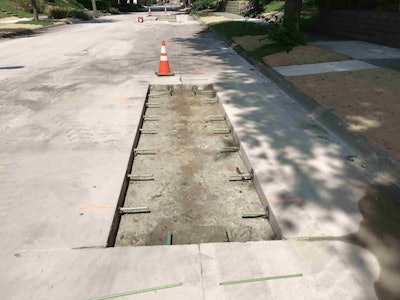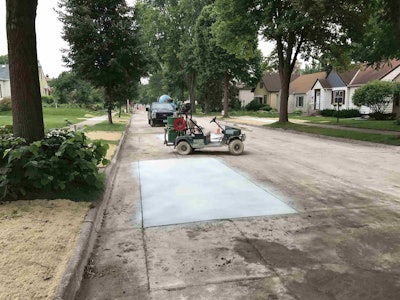 In Minneapolis, crews work to improve streets by using a progressive concrete preservation strategy. Above, workers carry out a full panel pour. Photos: International Grooving & Grinding Association.
In Minneapolis, crews work to improve streets by using a progressive concrete preservation strategy. Above, workers carry out a full panel pour. Photos: International Grooving & Grinding Association.
With the inevitable freeze-thaw cycles in Minneapolis leading to pavement damage every winter, drivers are vocal about their desire for the city to fix potholes and maintain roads, according to the International Grooving & Grinding Association (IGGA), a non-profit trade association.
Every spring in Minneapolis, drivers find themselves trying to avoid the worst of the potholes and the damage that they sometimes do to vehicles. The expansion joints of concrete streets have deteriorated, and moisture from melting snow or rain is getting into these joints. Cracks, water, winter cold and summer sun can lead to potholes.
Kristin Dispenza, a spokeswoman for the association, explains that road owners have long looked to break this annual cycle by identifying repair methods that can better withstand the Midwest’s harsh winter weather. The City of Minneapolis’ 2017 Concrete Street Rehabilitation Program is expected to implement cost-effective solutions, according to Dispenza.
The work continues this year under that program. The following is content about the strategy that Dispenza provided to Equipment World on behalf of IGGA.
Throughout the City of Minneapolis there are 155 miles of concrete streets. These residential streets were constructed between 1961 and 1976, making them, on average, 45 years old.
“It is common knowledge that there is a lot of life left in those pavements and that taking advantage of the remaining service life could save money in the long run,” says Matthew Zeller, executive director of the Concrete Paving Association of Minnesota (CPAM).
When applied to a structurally sound pavement in the proper time frame, concrete pavement preservation (CPP) is an extremely beneficial approach. CPP is a series of engineered techniques developed over the past 50 years to rehabilitate and renew concrete pavement. These techniques have proven effective for deteriorated highways, but they also offer an alternative to asphalt overlays when rehabilitating city streets constructed of concrete.
The process targets and repairs areas of distress within otherwise sound concrete pavements. CPP can be performed in small work areas and at off-peak hours, with the repairs often lasting for decades.
 Crews working on a full panel removal in Minneapolis, where the freeze-thaw cycle contributes to potholes and other pavement damage.
Crews working on a full panel removal in Minneapolis, where the freeze-thaw cycle contributes to potholes and other pavement damage.CPP is designed for well-worn pavement in need of renewal and is a sustainable approach because it reuses existing materials rather than requiring large quantities of natural resources such as aggregate and bituminous oil. In addition to extending pavement life it improves a pavement’s surface friction, enhancing safety when utilizing diamond grinding and/or grooving. CPP’s basic techniques include:
- Slab stabilization: restores support to concrete slabs by filling small voids that develop beneath the slab at joints, cracks or pavement edges.
- Full-depth repair: fixes cracked slabs and joint deterioration by removing a portion of the existing slab full depth and replacing it with new concrete.
- Partial-depth repair: corrects surface distresses and joint-crack deterioration in the upper third of the concrete slab. A partial-depth repair involves removing the deteriorated concrete, cleaning the patch area, placing new concrete and reforming the joint system, if necessary.
- Dowel bar retrofit: involves cutting slots in the pavement across a transverse joint or crack, cleaning the slots, placing the dowel bars, and then backfilling the slots with new concrete. Dowel bar retrofits link slabs together at transverse cracks and joints, so that the load is evenly distributed across the crack or joint.
- Cross-stitching longitudinal cracks or joints: repairs low-severity cracks. Reinforcing steel is added to hold the crack together tightly to preserve aggregate interlock.
- Conventional diamond grinding (CDG): removes faulting, slab warping, studded-tire wear, and unevenness resulting from patches to create a smooth, uniform pavement profile. Diamond grinding reduces road noise by providing a longitudinal texture that is quieter than transverse textures. The longitudinal texture also enhances macro texture and skid resistance in worn and polished pavement surfaces.
- Joint and crack resealing: minimizes the infiltration of surface water and incompressible material into the joint system. Less water entering the joint reduces subgrade softening, slows pumping and erosion of subbase fines, and may limit dowel bar corrosion caused by de-icing chemicals.
“Minneapolis’s residential streets have likely already exceeded their intended design life, but they’ve held up so well over time—largely because of the low volume of traffic—that performing these repairs will add 20-30 years of useful life,” says Sam Gramling, president and CEO of Interstate Improvement, Inc.
The Minneapolis City Council recently authorized an additional $21+ million annually for capital improvements in the city’s transportation system, according to the Minneapolis Department of Public Works. As part of that authorization, the council specified that public works must use a criteria-based system with a focus on racial and economic equity to determine an equitable distribution of funding with an overarching goal of maintaining pavement condition.
During the planning process, the Concrete Street Rehabilitation Program was identified as a priority to extend the useful life of concrete streets that primarily serve residential neighborhoods throughout the city. The program will rehabilitate approximately 3-4 miles of concrete streets per year.
“The program is a cost-effective way to address deteriorating pavement and postpone the need for more costly reconstruction projects, according to the city’s website, which also outlines their process for identifying pavement sections for improvement: evaluations are performed based on age and condition, work history, planned utility work and best practice pavement management strategies.
 Full depth joint removal under the Concrete Street Rehabilitation Program in Minneapolis. Dowel bars link slabs together at transverse cracks and joints. This helps fix cracked slabs and joint deterioration.
Full depth joint removal under the Concrete Street Rehabilitation Program in Minneapolis. Dowel bars link slabs together at transverse cracks and joints. This helps fix cracked slabs and joint deterioration.
Strategic Planning Conserves Resources in Minneapolis
Over the next two years, it is expected that 80-85 of Minneapolis’s city blocks will be repaired as part of the Concrete Street Rehabilitation Program. Work is being performed by both city personnel and Interstate Improvement, Inc., along with that company’s subcontractors. This balance of public and private work was arrived at through experimentation and analysis.
For an early concrete repair project encompassing a five-six block area, Minnesota-based contractor PCi Roads was contracted to perform partial depth repair and Diamond Surface, Inc. of Rogers, Minn. performed diamond grinding.
The remainder of work was performed by the City of Minneapolis using its own maintenance staff. Lessons learned on this early project were used to determine the most effective way to proceed with the remainder of the rehabilitation work. In some instances (typically small, two-to-three block areas without specialized CPP needs) city forces are well-equipped to do the work themselves. In other locations, contractors are used to perform skilled work such as full or partial depth repair.
Another efficiency that Minneapolis brought to the process was to do a thorough preconstruction assessment. Concrete work is a specialized type of construction, therefore it makes sense for all project stakeholders to come together before site work actually begins. The City of Minneapolis met with CPAM representatives to conduct a site visit and assess the pavements before bidding the project.
They then worked with a local engineering firm to design and inspect the project. Several potential prime contractors were invited to come to the site individually and walk through some of the blocks so that the engineers could brainstorm with the contractors. Finally, the city and their consultant held a pre-bid meeting to discuss the constructability and answer any questions.
When Interstate Improvement, Inc. was selected as the prime contractor, they performed a more thorough assessment, walking the project area street by street along with the engineers and the city.
Another means of enhancing the effectiveness of the Concrete Street Rehabilitation Program was to use Indefinite Delivery/Indefinite Quantity (IDIQ) contracting. IDIQ contracts outline overall project completion goals (usually quantified in number of years) and a minimum/maximum dollar amount for the overall contract.
During construction, individual task orders are executed. Each task order has a minimum dollar amount, which prevents situations in which the contractor would have to mobilize overly small work areas. The contracting method allows owners flexibility in performing work while dealing with ever-changing budget restraints. To manage their budget, owners can issue smaller or fewer task orders for a given project and then transfer leftover funds to a different project within the IDIQ pool of work. Conversely, if they get lower pricing than anticipated on an IDIQ project, more of the total projected work can be performed. IDIQ contracts usually span approximately two years, during which time contractors hold their pricing steady.
For the City of Minneapolis, the current project’s final completion date is December 31, 2018 and the minimum task order is $100,000 each. The minimum overall contract is $2,750,000 and the maximum is $7,000,000.
 A completed full panel of new concrete on Penn Avenue South on Minneapolis’ south side. The city’s renewed pavements are expected to last another 25 years.
A completed full panel of new concrete on Penn Avenue South on Minneapolis’ south side. The city’s renewed pavements are expected to last another 25 years.
Concrete Pavement Restoration in Waite Park
Waite Park is a neighborhood in Northeast Minneapolis, and repairs there were addressed with the concrete preservation strategy.
The concrete streets included in the 2017 program are located in two distinct zones within the Waite Park neighborhood, totaling 6-8 miles of streets. Construction began in the summer of 2017. The original pavements were constructed in 1967 and 1968 and were good candidates for concrete repair techniques.
Repairs consisted of saw cutting, full-depth concrete patching, partial depth concrete patching, diamond grinding, joint and crack sealing, spot curb replacement, manhole and inlet adjustments, ADA ramp construction and restoration. Diamond grinding was performed to create a smooth and safe finished surface. Traffic was managed using the city’s extensive alley system. The majority of residential blocks have alley access to homes, which allowed the main streets to be fully closed during the duration of construction. Streets without alley access were posted for no parking in advance and closed one half-block at a time to maintain access.
Original costs of the Waite Park work were projected to be $4,000,000. Of that total, approximately $2,600,000 was for concrete repairs, $500,000 for diamond grinding and the rest for incidentals like manhole/inlet adjustments, ADA work, and curb replacement.
Minneapolis’s renewed pavements are expected to last another 25 years, making the total lifespan of the concrete streets 65-70 years. With only one major preservation cycle during that timeframe, this translates into a very low annual cost for concrete city streets.
“With increasing demands and diminishing transportation funding, city managers are compelled to look for new and innovative ways to stretch their budgets and maximize pavement longevity,” says John Roberts, executive director, International Grooving & Grinding Association.
“It is truly good fortune that their predecessors chose to build many of the city’s streets using long lasting concrete pavement. It is even more fortunate for the taxpayers of Minneapolis that their elected officials were willing to look at best practices abroad and develop a system of pavement renewal that is economical, long lasting and safe. I suspect that you will soon see other municipalities adopt this truly efficient model of pavement renewal, once word gets out.”
About IGGA: The International Grooving & Grinding Association (IGGA) was founded in 1972 by industry professionals committed to the development of the diamond grinding and grooving process for surfaces constructed with Portland cement concrete and asphalt.
In 1995, the IGGA joined in affiliation with the American Concrete Pavement Association (ACPA) to form today what is known as the IGGA/ACPA Concrete Pavement Preservation Partnership (IGGA/ACPA CP3). The partnership serves as the technical resource and industry leader in the marketing of optimized pavement surfaces, concrete pavement restoration and pavement preservation around the world.
About Kristin Dispenza: Through the consulting firm Advancing Organizational Excellence, Dispenza provides sponsored content about the nonprofit IGGA.












